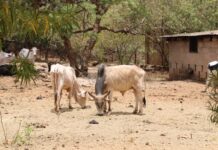|
Getting your Trinity Audio player ready...
|
By Winnie Kamau
Nairobi, Kenya: In Kenya, a proposed bill known as the Mung Beans Bill of 2022 has sparked controversy among netizens on social media. The bill aims to regulate and promote the mung bean industry in the country by introducing stringent measures, including registration and licensing requirements.
If passed into law, the bill would make it an offense to cultivate mung beans without a valid license, punishable by a substantial fine of up to 1 million Kenyan shillings or a two-year prison sentence, or both. This has drawn criticism and concern from citizens who expressed their disapproval online.
According to the clarification sent by the proposer of the Bill, Kitui County Senator Enoch Kiio Wambua saying the Bill mandates that small and medium-sized mung bean farmers register with their respective County Executive Committee (CEC) member.
 The Senator said many Kenyans were misinformed “This practice is already common for other crops like tea and coffee. According to Clause 8 (2) of the Bill, the purpose of this registration is threefold to maintain an accurate register of all mung bean growers, to record essential details such as the location, size, and variety of mung beans cultivated and to assess the potential crop capacity within counties and across the country”.
The Senator said many Kenyans were misinformed “This practice is already common for other crops like tea and coffee. According to Clause 8 (2) of the Bill, the purpose of this registration is threefold to maintain an accurate register of all mung bean growers, to record essential details such as the location, size, and variety of mung beans cultivated and to assess the potential crop capacity within counties and across the country”.
The Bill proposes that all individuals or entities involved in marketing, processing or large-scale trading will be required to get a license for mungbean and related products. This requirement is specified in Clause 9 (1) of the Bill.
The registration of small and medium-sized mung bean growers is designed to help the government gain a better understanding of the industry and support its development. According to Senator Wambua, data is crucial for formulating strategies that can make Kenya’s mung bean industry more competitive on the global stage.
“The Bill aims to establish a framework that will regulate and promote the mung bean industry in Kenya, ensuring its growth both locally and internationally” Senator Mutua said.
The registration process is intended to support these goals, not to penalize farmers.

Contrary to some misconceptions, the Bill does not require a license to grow mung beans; it only requires registration for small and medium-sized farmers, as is the case with other regulated crops. Licensing is exclusively for commercial activities such as processing and large-scale trading.
Earlier in March this year, the International Mungbean Congress was held in Bangkok bringing together 110 stakeholders from 23 countries, providing a platform for sharing the latest research and setting future priorities for the mungbean industry, including those supported by Australian Centre for International Agricultural Research (ACIAR).
Dr. Eric Huttner, ACIAR’s Research Program Manager for Crops, emphasized the significant impact ACIAR’s investment in mungbean improvement research could have on partner countries. ACIAR has been actively supporting the International Mungbean Improvement Network and various projects aimed at intensifying cropping systems in these regions.
“Mungbean is valuable both economically and nutritionally, and due to previous limited research investment, we have a unique opportunity to make substantial improvements quickly,” Dr. Huttner stated.
The congress, held in Bangkok in March 2024, was the first gathering of mungbean-focused researchers since 1987. Dr. Huttner highlighted the advancements in genomic resources and multi-location germplasm trials, which are enhancing the understanding of mungbean genetics. This growing knowledge, coupled with the increased capacity of researchers, is expected to accelerate the breeding of new, improved varieties.
On the third day of the congress, a workshop identified key research priorities for the mungbean industry looking toward 2030. These priorities include the development of improved mechanized harvesting methods, heat, drought, and salinity-resistant varieties, and enhanced resistance to biotic stresses such as diseases and pests. Dr. Ramakrishnan Nair, a legume breeder at the World Vegetable Center (WorldVeg) and leader of the International Mungbean Improvement Network, expressed excitement at the diverse international participation and the collaborative focus on improving the crop.
 Dr. Nair highlighted the integration of phenotypic and genotypic data as a priority to breed varieties with desirable traits like disease resistance, tailored to the specific needs of different regions. This aligns with the active goals of the International Mungbean Improvement Network, which was established in 2016 to enhance mungbean productivity and improve the livelihoods of farmers.
Dr. Nair highlighted the integration of phenotypic and genotypic data as a priority to breed varieties with desirable traits like disease resistance, tailored to the specific needs of different regions. This aligns with the active goals of the International Mungbean Improvement Network, which was established in 2016 to enhance mungbean productivity and improve the livelihoods of farmers.
The network has built an extensive library of mungbean varieties, including 8,000 accessions capturing the crop’s genetic diversity. Of these, a core collection of 1,500 and a mini-core of 296 accessions are most widely shared with partner countries. The mini-core collection has been evaluated for resistance to both biotic (insects and diseases) and abiotic (salinity and waterlogging) stressors, as well as various physical traits.
With help from local manufacturers, 2 mungbean de-husking machines were trialed in 2022, with refinements made after initial trials to improve efficiency. This reduced the de-husking of mung beans from 7 rounds of processing to 3 rounds. The proportion of beans damaged in the process was also reduced from 20% to 5–10%.
The network’s efforts have already yielded new varieties, including two released in Tanzania and three in Kenya, featuring higher yields, shorter growing seasons, and improved disease resistance. Dr. Nair also discussed the importance of developing plant traits suited to different cropping systems, noting that while early-maturing varieties have been a focus, later-maturing varieties might offer higher yields under certain conditions.
In addition to crop improvement, the congress addressed the importance of strong value chains for smallholder farmers. Dr. MG Neogi from the University of Western Australia, based in Bangladesh, discussed value-adding opportunities for smallholder farmers in his country. He highlighted how small changes in farming practices, such as incorporating salt-tolerant wheat and pulses into crop rotations, have significantly increased returns from mungbean crops in southern Bangladesh.
“This one change – establishing a mini mill in a community – has changed the entire picture,” said Dr. Neogi.
“The local community has better access to mungbean for their own use and, with the almost doubled profit, farmers are able to invest more in their crops, such as using pesticides and fertilizers, so their yields have increased” added Dr. Neogi.
Dr. Neogi explained that mungbean is an ideal dry-season crop following the rice harvest in southern Bangladesh. However, local farmers faced challenges due to low farm-gate prices and the absence of mungbean de-husking machines. The project team collaborated with local manufacturers to develop and install de-husking machines, which reduced processing rounds and damage rates, significantly increasing farmers’ profits.
“Some countries represented at the conference expressed that they were having some similar problems, so I am optimistic about the future extension of the knowledge gained through this project both in Bangladesh and in other countries facing similar challenges” noted Dr. Neogi.
According to Dr. Neogi the installation of “mini mills” in 21 communities allowed smallholders to de-husk their mung beans locally, boosting their income and enabling further investment in their crops. Dr. Neogi shared that other countries facing similar challenges expressed interest in adopting these strategies, highlighting the potential for broader impact beyond Bangladesh.














